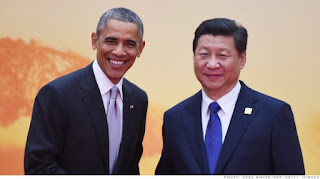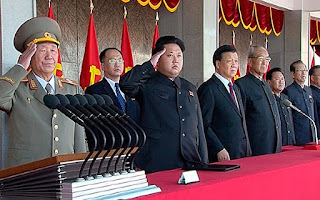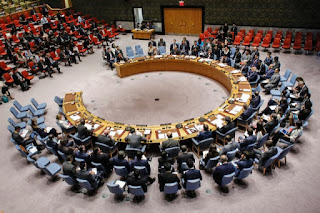China’s Artificial Island in the South China Sea
China’s
Artificial Island in the South China Sea
By
E. Stanley Ukeni
As the dispute over the strategic waterways of the South
China Sea intensifies, the United States’ government has, in recent months,
began to more publicly challenge China’s claims over the Spratly and Paracels
Islands where China has carved out a sizable acreage of Island from what were
once open stretches of South China Sea. The newly created artificial Island is
located around a busy shipping route connecting the Strait of Malacca and the
Pacific Ocean—making it a strategically important shipping route.
Although Washington has long maintained a position
of non-interference in the decades old sovereignty dispute over the Island
chain by several countries in the region, it is now being compelled to take a
more assertive stands because of the prospect of china using the artificial
Island to lay claims to the surrounding airspace and the island’s perimeter water.
China stepped up its construction of the artificial
Island about a couple of years ago. The breakneck speed at which China was able
to employ decades old land reclamation process helped the country to
effectively turn reefs, which are usually underwater at high tide, into a
permanent island in record time. As a result, in about a period of eighteen months,
SDC Orient Dredging and Engineering Company, along with the other companies contracted
by the Chinese government to undertake the herculean project, has been able to
reclaim over two thousand acres of land area (800 hectares).
China’s stepped up process of land reclamation, as
it carves out an artificial island from the sea, alarmed several countries in
the Asia-Pacific Region, and drew harsh rebuke and criticism from the United
States’ government. The U.S. has refused to recognize china’s claim of sole sovereignty
over the contested islands.
Echoing the sentiment of the U.S position, The
United States’ Defense Secretary, Ashton Carter, said in late May that, “Turning
an underwater rock into an airfield simply does not afford the rights of
sovereignty or permit restrictions on international air or maritime transit…”
White House spokesman Josh Earnest said President Barack Obama considered the South China Sea security situation "critically important" to U.S. national security and the global economy. He further added that Washington was committed to working with other Asia-Pacific states to protect the free flow of commerce in the Asia-Pacific Region.
In mid-June, the Chinese government finally revealed
an official account, detailing the sort of infrastructures that it is constructing
in the artificial island it reclaimed in the South China Sea. The country’s top
planning agency, the National Development and Reform Commission (NDRC), issued
a short statement indicating that it had concluded plans for the use of civil
facilities on the Spratly Islands.
The NDRC indicated that the facilities would help it
improve the living conditions on the island and also enable China to fulfill
its international obligations of environmental monitoring, disaster relief and
navigational safely in the Asia-Pacific Region.
This official assertion lists lighthouses,
communications stations and other facilities for civilian and emergency uses as
some of the main infrastructures being built on the more than 2,000 acres
artificial island that the Chinese has thus far reclaimed. However, this
official revelation does not seem to quell the suspicion of many countries
regarding the undeclared intentions of the Chinese government—particularly its
military intent for this artificial island.
In early June, the secretary of the Australian
defense department, Dennis Richardson, told his country’s Senate that, “the
land reclamation activity by China in the South China Sea has been at a pace
and scale, in the last two years, beyond anything we have previously seen. And the
size of the land reclamation does raise questions about its purpose”.
The Australian
government is particularly concerned because the artificially created island is
strategically situated within an important shipping route for the country’s
naval and merchant vessels. However, although the Australian government is
quite alarmed by the evolving development in the South China Sea, many of the
country’s prominent politicians and business leaders have quietly urged the
government to tread cautiously on the South China Sea issue. The one area that
the Australians want guarantees is on the freedom of navigation and maritime
security.
However, even as the Australian government has
chosen to tread softly on the Spratly Islands dispute, there is a popular
narrative within the country’s military circles that China intends to
militarize the artificial island that it is building in the South China Sea. The
claimants of parts of the disputed Spratly islands—which includes Japan,
Malaysia, Brunei, Vietnam and the Philippines all seem to share this sentiment.
Whatever, although there may appear to be what seems
like an escalation of tensions in the Pacific, it’s not likely that the ongoing
contention between the U.S and the Chinese military in the South China Sea will
lead to a conflict.
This sentiment was further bolstered by Senator John
McCain, chairman of the Senate's
Armed Services Committee, at a news conference in Ho Chi Minh City. The US Senator
and former Presidential Republican candidate said, “…It is a disturbing
development and escalatory development, one which heightens our need to make
the Chinese understand that their actions are in violation of international law
and their actions are going to be condemned by everyone in the world.”
The US
Senator further stressed that, “We are not going to have a conflict with China
but we can take certain measures which will be a disincentive to China to
continue these kinds of activities.”
This tension between the two world powers, I’m
fairly certain, will be front and center in this year’s Sino-U.S. dialogue in
Washington DC. I feel that the South China Sea tension is merely an interlude in
both countries’ strengthening bilateral relationship.
Authored by E. Stanley Ukeni, © 2015. All Rights
Reserved.










Comments
Post a Comment